
- Home Page
- Accepted
Paintings & Copies - Doubtful
Attributions - Doubtful Textual References
- Alternative
Titles - Collectors &
Museums - Bibliography
- Search Abecedario
- Watteau &
His Circle
Fêtes au dieu Pan
Entered May 2019; revised January 2020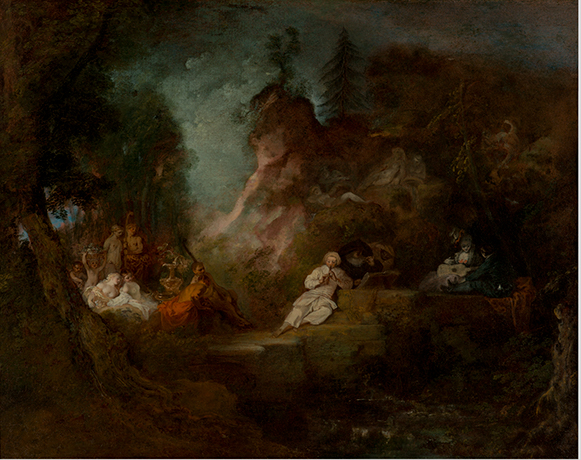
Los Angeles, Armand Hammer Museum, inv. AH.91.48
Oil on canvas
65 x 82 cm
ALTERNATIVE TITLES
Festivities in Honor of Pan
Feste in onore del dio Pan
Festes au dieu Pan
Fête au dieu Pan
Fêtes of the God Pan
Youth Playing the Flagelot in a Landscape with Satyrs and Nymphs
RELATED PRINTS
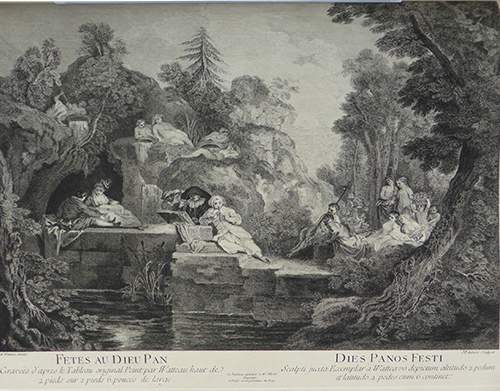
Fêtes au dieu Pan was engraved in reverse by Michel Guillaume Aubert, but outside of Jullienne’s Oeuvre gravé. It was later added to that corpus. The print was announced for sale in the April 1734 issue of the Mercure de France, p. 753.
PROVENANCE
Paris, collection of François Morel (banker), c. 1720. Cited on the Aubert engraving: “Ce Tableau apartien à Mr Morel, Banctier”; by descent in the Morel family.
Lyons, collection of Louis Morel de Voleine (1812-1894; author) or his son with the same name (cited by Paul Mantz, 1892).
Paris, collection of Camille Groult (1837-1908; heir to a fortune from flour milling). His sale, Paris, Galerie Georges Petit, June 21-22, 1920, lot 114: “WATTEAU (JEAN-ANTOINE) . . . Fêtes au dieu Pan. A gauche, sur une hauteur boisée, des naïades se penchant sur de urnes et, à l’entrée d’une grotte qui domine un basin où croissant des Roseaux, un jeune homme est assis près d’une jeune femme ayant une guitare sur ses genoux. Gilles, au centre, joue de la flûte, accoudé sur un pierre. A ses côtés, un homme, tenant un des besicles, s’incline sur un livre près d’un mezzetin. A droite, deux satyres, des nymphes et deux enfants. L’un porte sur sa tête une corbeille de fleurs.
Toile. Haut., 65 cent; larg., 82 cent.
Gravé par M. AUBERT, avec la mention: le tableau original, haut de 2 pieds sur 2 pieds 6 pouces de large, le tableau appartient à M.Morel, banctier. Cité dans le Catalogue raisonné de l’oeuvre peint, dessiné et gravé d’Antoine Watteau, par Edmond de Goncourt, Paris, Rapilly, 1875, p. 47, no 40.”
Sold to Galerie Trotti, according to an annotated copy of the sale catalogue in the Wildenstein and Co. library.Paris, with Galerie Trotti et Cie.
New York, with Wildenstein and Co., c. 1926 (cited in 1926 Detroit Institute of Arts exhibition; also in Dacier, Vuaflart, and Hérold, Jean de Jullienne et les graveurs de Watteau [1921-29], 3: 265).
New York, collection of Henry Emil Stehli (1902-1955; silk merchant). His sale, New York, Parke Bernet Galleries, November 30, 1950, lot 16: “JEAN ANTOINE WATTEAU . . . FETE AU DIEU PAN. A youth in white pierrot costume of the Commedia dell’ Arte reclines on a rug in the central foreground playing a flageolet, a second beruffed figure behind him singing from an open antiphonary; to their right, a lady playing a lute, and a youth in dark blue watching her. At the left is an attentive group of half-naked satyrs and nymphs and a putto canephoros with a basket of flowers upon his head. Background of high craggy rocks and trees, with a third group of four nude satyrs and nymphs dimly outlined above the musicians. In extreme foreground the rocks circumscribe a small pool. 26 x 32 inches / Collection Morel, Lyons / Collection Groult, Paris / From Wildenstein & Co., Inc., New York / Recorded in Edmond & de Goncourt, Catalogue de Watteau, 1880, p. 47, no. 40 / Recorded in Edmond & Jules de Goncourt, L'Art du XVIIIme Siécle, 1880, p. 56 / Engraved by Michel Aubert / [See photogravure].” According to an annotated copy of the sale catalogue in the Frick Art Reference Library, the picture sold for $12,500.
New York, with Hammer Galleries; cited in the records of the Hammer Museum.
Memphis, Tennessee, collection of Morrie A. Moss (1907-93; businessman) and Lillian Moss (1905-1985).
New York, with Knoedler, c. 1983. See the letter from Marianne Roland Michel, May 4, 1983, to Nancy C. Little of Knoedler, now in the Roland Michel Archives, Petit Palais, Paris.
Los Angeles, collection of Armand Hammer (1898-1990; capitalist), bought directly from Moss in March 1984, circumventing Knoedler.
Estate of Armand Hammer.
EXHIBITIONS
Detroit, Detroit Institute of Arts, The Fourth Loan Exhibition of Old Master, French Paintings of the Eighteenth Century, December 2-20, 1926, cat. 53 (Jean Antoine Watteau . . . Festival to the God Pan, lent by Felix Wildenstein).
Jerusalem, Israel Museum, Armand Hammer Collection (1986) (Watteau, Festivities in Honor of Pan, lent by the Armand Hammer Collection).
SELECT BIBLIOGRAPHY
Hédouin, “Watteau” (1845), cat. 85.
Hédouin, Mosaïque (1856), cat. 86.
Goncourt, L’Art au XVIIIème siècle, 56.
Goncourt, Catalogue raisonné (1875), cat. 40.
Mollet, Watteau (1883), cat. 40.
Mantz, Watteau (1892), 180-81.
Josz, Watteau (1904), 24, 29, 171.
Phillips, “An Unknown Watteau” (1904), 236.
Fourcaud, “Watteau, Scènes et figures théatrales” (1904), 198.
Zimmerman, Watteau (1912), 12-13.
Pilon, Watteau et son école (1912) , 175.
Dacier, Vuaflart, and Hérold, Jean de Jullienne et les graveurs (1921-29), 1: 16, 110; 2: 38, 96, 122; 3: cat. 276, p. 265.
Réau, “Watteau” (1928), cat. 18.
Barker, Watteau (1939), 32-33.
Adhémar, Watteau (1950), 37-38, 56 n. 39; cat. 10.
Munhall, "Gillot’s ‘Feast of Pan’” (1962), 35.
Macchia and Montagni, L’opera completa di Watteau (1968), cat. 9.
Roland Michel, Watteau (1981), cat. 14.
Posner, Watteau (1984), 53-54
Roland Michel, Watteau (1984), 212-13.
Rosenberg and Prat, Watteau, catalogue raisonné des dessins (1996), under cat. 126-28.
Brussels, Palais des beaux-arts, Watteau, Leçon de musique (2013), under cat. 30.
RELATED DRAWINGS
While we might expect to find studies for the many figures in the painting, only three are known and these are for two of the commedia dell’arte characters in the central portion of the composition.
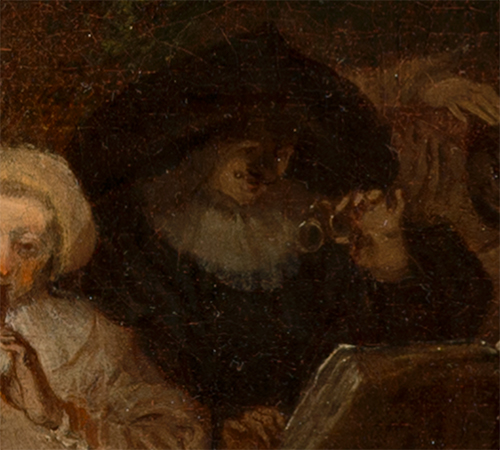
Watteau, Fêtes au dieu Pan (detail).
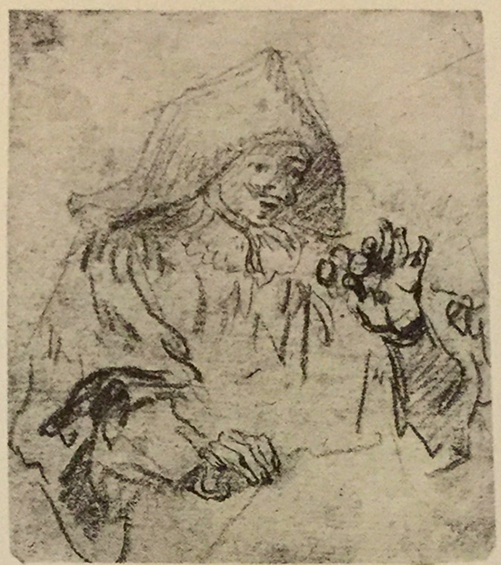
Watteau, Study of Dr. Baloardo, red chalk, 80 x 60 cm. Paris, Galerie Ratton-Ladrière.
A small drawing presently on the Paris art market, quite possibly cut from a larger sheet, served as the basis for the comic character at the center of the painting. There are slight adjustments—the fingers on his left hand, his ruff, the inclination of his body, the profile of the hat—but, otherwise, the correspondence is compelling.
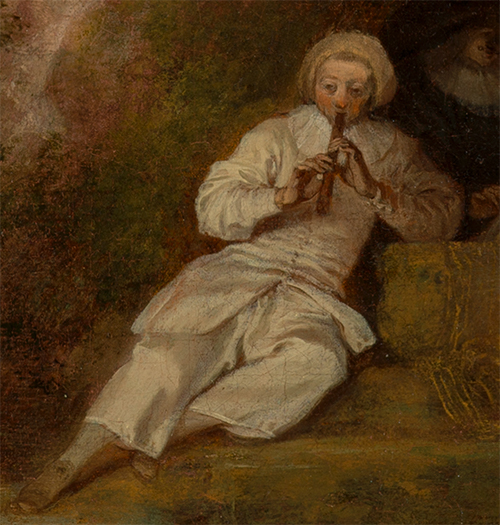
Watteau, Fêtes au dieu Pan (detail).
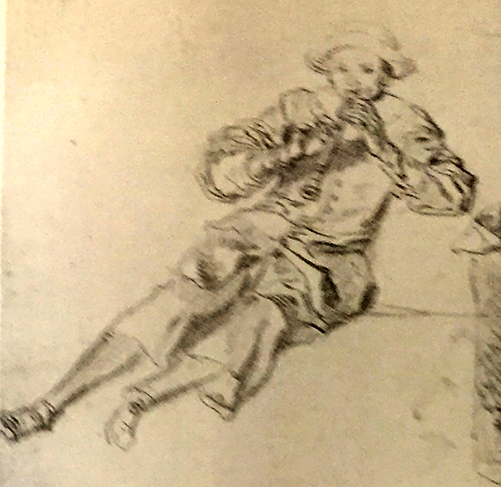
Watteau, Studies of Pierrot Playing the Flute and a Kneeling Man (detail), red chalk, Stockholm, Nationalmuseum.
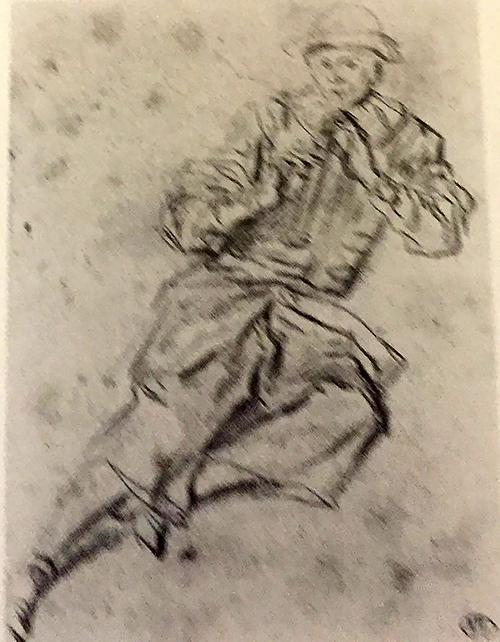
Watteau, Study of Pierrot Playing the Flute, red chalk, Paris, Musée du Louvre, Département des arts graphiques.
The figure of Pierrot playing the flute was studied twice by Watteau. The first is a sheet in the Stockholm Nationalmuseum (Rosenberg and Prat 126) which Count Tessin obtained directly from the artist in 1715, thus giving iy a terminus ante quem. The figure is drawn in a tightly controlled manner, with linear precision. The second study of this actor, drawn in a much freer, energetic way, is now in the Louvre (Rosenberg and Prat 127). In this reworking, the position of the left leg has been changed: it is bent at the knee and tucked under the right leg above the calf, just as it is in the painting. As a result, Pierrot’s pant leg is pulled up and it flares differently, as does his jacket. It should also be noted that in this second drawing, his right arm is held more closely to the torso and the brim of the hat is arranged differently, as in the painting. Other changes were introduced: The flute in the drawing flares slightly at the tip, but is flat-ended in the painting.
REMARKS

Watteau, Fêtes au dieu Pan.
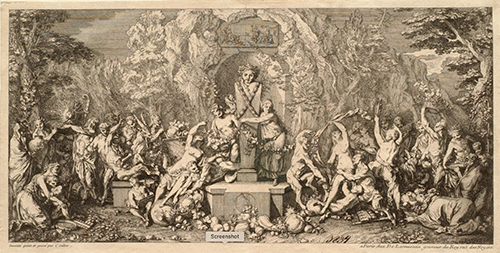
Claude Gillot, Feste de Bacchus, engraving.
Fêtes au dieu Pan is a remarkably early painting, closely tied to Watteau’s stay with Claude Gillot. This woodland glen with its host of satyrs around a centrally focused celebration recalls several scenes engraved by Gillot, especially his Feste de Bacchus and Feste de Diane. In both of Gillot’s compositions, the worship of the cult statue disrupted by satyrs create havoc. In Watteau’s painting, by contrast, the satyrs are tranquil and almost meditative, a mood that is generally prevalent in his works. Strengthening this comparison is the formulation of the titles but, of course, we do not know what title Watteau used; the present title appeared only with the engraving, a decade after the artist’s death.
Whereas Gillot’s compositions feature worshippers of a central cult statue, there is no dominant divinity in Watteau’s composition. Rather the assembled people and satyrs attend to three commedia dell’arte figures: Pierrot playing a flute, the Doctor holding his pince-nez as though he were reading, and a Harlequin making his traditional mocking gesture. As witth many of Watteau’s paintings, the meaning of this is ambiguous. Is it parodic or does it represent a theatrical performance? We also might wonder why Pierrot is playing a flute: normally he is shown holding or strumming a guitar.
Despite the title emphasizing Pan’s role, the symbols of Bacchus are equally abundant. At the left are two followers of Bacchus: the man baring his torso but wearing a leopard skin, his companion a lightly draped bacchante with one breast bared. A large ewer, presumably for wine, is prominent. However, some emblems of Pan may be present. A noticeable element in the landscape is the pine tree on a high hill at the center background—an unusual choice of tree for Watteau. Possibly this was to remind us of the story of Pitys, a nymph Pan loved. Fleeing his advances, she was transformed into a fir or pine tree. In the foreground pool, growing out of the water (now visible only in Aubert’s engraving), are reeds—the plant into which the nymph Syrinx was transformed and from which Pan fashioned his reed flute. Were Pierrot playing the so-called pipes of Pan rather than a flute, the subject of the painting might be more explicit.
The painting has suffered greatly over the years, and much of the landscape is completely lost or reconstructed. Conversely, the figural elements are remarkably well preserved. This disparity may reflect the way Watteau painted: while lavishing care on the figures, he appears to have filled in the areas of foliage quickly, using an oxidant to hasten the drying. In time this caused the surface to darken and develop an unpleasant, alligator-skin surface which led to scraping and overpainting.
Marco Grassi examined the painting in the fall and winter of 1982-83 for Knoedler, and he removed old varnish and restorations. He wrote that “ some of the areas, such as the upper background, were almost completely obliterated. The present procedure was concerned principally with . . . attenuating the severely damaged peripheral areas.” In 1985 he again reported on the poor condition of the landscape and wrote “I had inpainted only those parts which were absolutely necessary, toning in the others with no attempt at recreating what might have been a finished image.” Grassi was so struck by the condition of the landscape that he conjectured that these areas had been only “partially finished” and “had suffered further in the interim.” Writing again in October 1985, he proposed “that it is tempting to think that the paintings may not, in fact, have been entirely finished” by Watteau.
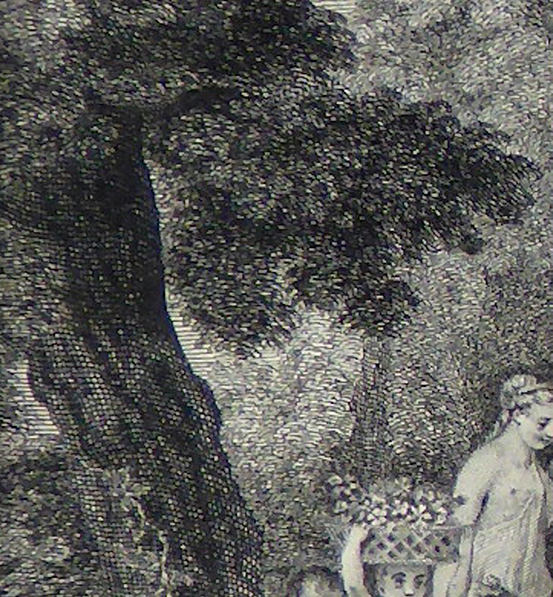
Michel Guillaume Aubert after Watteau, Fêtes au dieu Pan (detail), engraving.
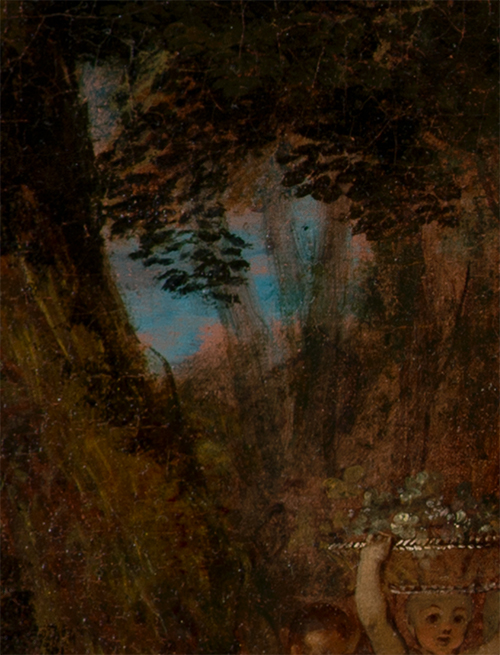
Watteau, Fêtes au dieu Pan (detail).
Grassi’s conjecture that the painting was left unfinished by the artist defies reason. Aubert’s engraving of the work, executed when the painting was still fresh and in good condition, proves that Watteau did indeed finish the entire surface and with great detail—all the varieties of trees, the shrubbery, the rocks of the grotto. The extent of the loss and the subsequent disfigurement of the landscape can be gauged by comparing a section of the background in the engraving above the leftmost group of figures with the very same passage in the actual painting. The main tree trunk has a different contour, the tree’s foliage has been entirely reshaped, and subsidiary saplings have been added. The bright patch of light blue sky is a modern intrusion.
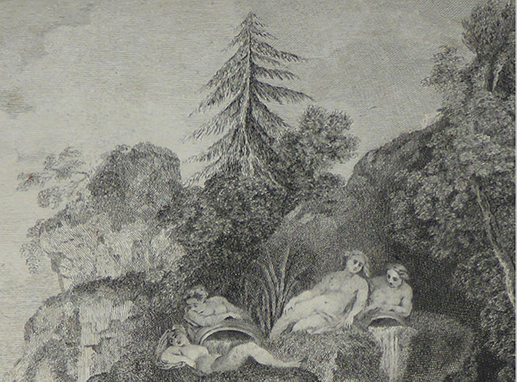
Michel Guillaume Aubert after Watteau, Fêtes au dieu Pan (detail), engraving.
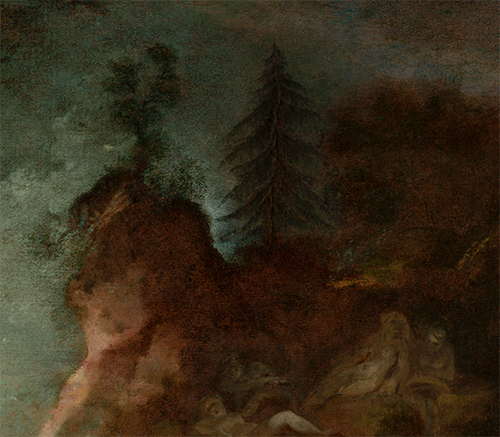
Watteau, Fêtes au dieu Pan (detail).
Similarly, we might consider the distant landscape in the central portion of the painting. The trees and rocky outcroppings are wholly the work of modern “restoration.” Yet it cannot be considered restoration, since it is largely a new invention and does not conform to Aubert’s print. The trees at the left and the amorphous brown mass to the right do not correspond in any way to Aubert’s record of what Watteau had designed.
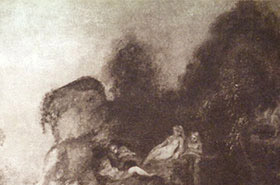
Seemingly the only point of correspondence is the pine tree, but even that proves illusory. A photograph of the painting when sold from the Stehli collection in 1950 shows that at that moment there was no pine tree whatsoever. The tree presently visible must be accounted a modern reconstruction, and even the present reconstruction does not match what Aubert engraved. Also the high, triangular mass of foliage in the upper right corner of Stehli’s painting does not correspond to Watteau’s original design nor the present state of the painting, recalling again how the painting’s landscape has suffered.
If scholars are agreed that the painting is Gillotesque and should be dated early in Watteau’s career, after he finished his apprenticeship, their opinions diverge widely as to its year. Adhémar dated Fête au dieu Pan to c. 1703-08, Macchia and Montagni suggested 1705, while Roland Michel proposed c. 1706-08. However, Grasselli as well as Rosenberg and Prat would place the preliminary drawings and painting considerably later, c. 1711-12. This later dating seems more reasonable.

Watteau, Fêtes au dieu Pan
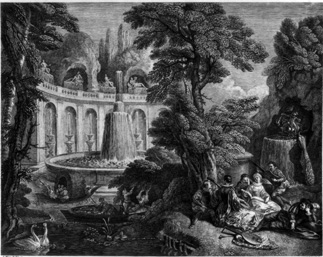
Jean Moyreau after Watteau, L’Été, engraving.
If Fêtes au dieu Pan cannot be dated precisely, nonetheless, as singular as it may seem, it can be related to other early paintings by Watteau. In particular, it is analogous to L’Été, the picture representing summer from the Saisons Jullienne, recorded in an engraving by Jean Moyreau. The two paintings share the same heavily forested landscape with clusters of people, a pool of water in the foreground, fountains and sculpted river gods in the background. This does not help date Fêtes au dieu Pan to a specific year, especially because the Saisons Jullienne cannot be dated precisely, but it does reinforce the unity of Watteau’s early oeuvre.
The provenance of the painting is exceptionally full. It remained with one family from its inception until the late nineteenth century, and its passage in the hands of dealers and collectors is well documented. In describing the provenance of this painting, Adhémar wrongly claimed that after the painting was with Groult, it went to “Charly,” and the sale on June 22, 1920, was of Charly’s collection. While the catalogue of that sale describes the collection as coming from “Monsieur X . . . ,” it is universely agreed that this was Groult’s collection. “Charly” is the sort of inexplicable error that frequently crept into Adhémar’s listings of provenance.
For copies of Fêtes au dieu Pan CLICK HERE